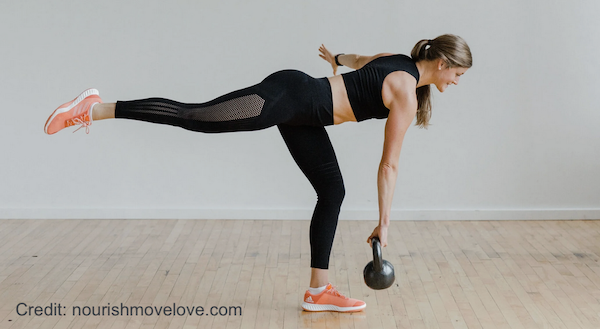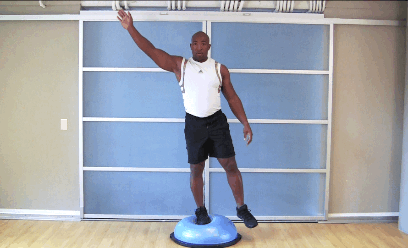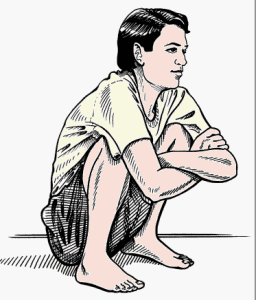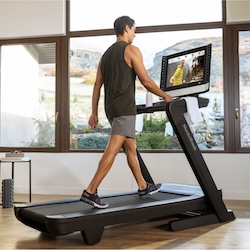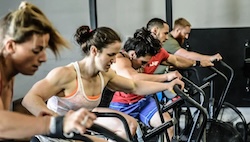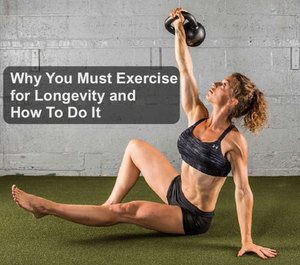4 Exercise Prerequisites for Longevity, Part 1
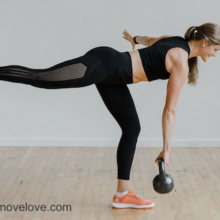
Exercise prerequisites for longevity are the four types of exercise you need to faithfully do if you’re going to spare yourself from the ravages of aging. Here I tell you why this is so, and what to do.
There are four exercise prerequisites for longevity. Exercise is the closest thing to a age-defying panacea that currently exists, and yet, according to the CDC’s FastStats on Exercise, only 46.9% of US adults aged 18 and older met the federal government’s physical activity guidelines for both aerobic and muscle-strengthening activities in 2020 [1].
And it gets worse with age.
Participation in recommended physical activity levels declines with age. For example, only 16.3% of adults aged 65 and over in the USA met the guidelines in 2020 [1].
Europeans aren’t doing much better.
While data points to variation across countries, Eurostat, the statistical office of the European Union, reported that nearly half (49.8%) of the population aged 18 or over in the EU did not do any sport or other physical activity [2]. (Scandinavians do better.)
For millennia, humans have pursued the elusive secret of immortality. Today, some chase this dream through unconventional means like hyperbaric chambers, cryotherapy, or bathing in infrared light. However, most experts doubt the effectiveness of these methods in significantly extending human lifespan, or healthspan. Instead, they advocate simple yet impactful behaviors that can promote longevity and vitality well into old age.
And as I’m about to explain, among those “impactful behaviors”, exercise reigns supreme, but it’s not the only important prerequisite for longevity. That’s why I wrote a four-part series to cover the basics:
- Part 1 you’re reading now
- Part 2 is about diet and chronic disease
- Part 3 is about hormones and detoxification; and
- Part 4 is about mindset, sleep and intimacy.
It can be persuasively argued that the exercise prerequisites I cover below are the most important inputs for longevity and healthspan by reducing the incidence and severity of the age-related chronic illnesses that kill us.
Regular physical activity is the most important of the prerequisites for longevity that I will cover in this series. Exercise consistently proves its ability to decrease the risk of premature death, bolstering the heart, circulation, and defense against various chronic ailments. Building muscle strength and balance during adulthood forms a robust foundation for aging well.
Regular exercise:
- Strengthens the heart, lowers blood pressure, and improves cholesterol levels, all of which reduce the risk of heart attack, stroke, and other cardiovascular complications [3][4].
- Helps regulate blood sugar levels by increasing insulin sensitivity and promoting glucose uptake by muscles. This can prevent or delay the onset of type 2 diabetes and improve management for existing cases [5][6].
- Helps combat the cluster of risk factors associated with metabolic syndrome, including obesity, high blood pressure, and abnormal cholesterol levels. This reduces the risk of developing associated conditions like heart disease, stroke, and type 2 diabetes [7][8].
- Can reduce inflammation, improve immune function, and influence hormone levels, potentially reducing the risk of certain cancers like colon, breast, and endometrial cancer [9][10].
- Stimulate bone formation and increase bone density, reducing the risk of fractures and osteoporosis [11][12].
- Can improve pain management by releasing endorphins, reducing inflammation, and strengthening muscles and joints. This can alleviate pain associated with conditions like arthritis and back pain [13][14].
- Can improve mood, reduce stress and anxiety, and boost self-esteem, all of which contribute to better mental health. It can also be beneficial for managing symptoms of depression and anxiety disorders [15][16].
You’d be hard pressed to live long and strong — the very essence of healthspan — without regular exercise.
If you exercise regularly, see if you’re investing in all four of the exercise prerequisites for longevity. And if you are not exercising regularly, I encourage you to examine the four exercise modalities I cover, and choose the one you’re least resistant to doing.
Here are the four exercise prerequisites for longevity and an extended healthspan:
Let’s look at each.
1. Stability is an exercise prerequisite for longevity
As I see it, stability has four components:
- Balance: This classic choice directly references the ability to maintain an upright posture and resist tipping.
- Equilibrium: Similar to balance, but with a more scientific connotation of equalizing opposing forces.
- Sturdiness: This emphasizes the strength and rigidity of the body, making it less likely to buckle or give way.
- Solidity: Similar to sturdiness, but with a stronger emphasis on compactness and resistance to external forces.
At its most basic, what we want is enough stability in our bodies so that if we trip, or step off a stair, we don’t fall down and break something. Falls are a major concern for older adults, with significant consequences for their health and well-being.
How consequential?
You be the judge.
Falls
- One in three adults aged 65 and over fall every year globally [17].
- Falls are the leading cause of injury-related deaths among adults aged 65 and older, accounting for over 31,000 deaths annually in the United States [18].
- The risk of falling increases with age and pre-existing medical conditions such as balance problems, muscle weakness, and vision impairments [19].
Hip Fractures
- Hip fractures are the most serious consequence of falls in older adults, with around 80% occurring in people aged 65 and over [20].
- The one-year mortality rate after a hip fracture ranges from 18% to 33% [21].
- Hip fractures significantly increase the risk of long-term health problems, including reduced mobility, functional decline, and increased dependence on others [22].
Diminished Health
- Even non-fatal falls can have serious consequences, such as pain, injuries, and a decline in physical and mental health [23].
- Falls can lead to a fear of falling, which can further limit mobility and independence [24].
- The financial burden of falls is significant, with an estimated cost of over $31 billion annually in the United States [25].
Obviously, you don’t want to contribute to those statistics, so work on your stability.
How?
Go to YouTube and search for “stability exercises”.
Here’s one I curated for you:
2. Mobility is an exercise prerequisite for longevity
Mobility is the ability to efficiently articulate (move) your joints through a full range of motion with control and stability, even under pressure or resistance where you would have to adapt to the “load” to maintain function, range and motion.
In much of the “developed” world, we sit a lot, and move little. Over time, you lose the capacity to do things like the so-called “peasant squat”, or have full shoulder mobility.
Ideally, as we age, we want to focus on range, control, stability (per above) and efficiency.
Focusing on range and control:
- Articulatory agility: This emphasizes the ability to move joints through a full range of motion with precision and control, even when weight or resistance is present.
- Loaded flexibility: This highlights the ability to maintain flexibility and freedom of movement in the joints while bearing weight or encountering external forces.
- Dynamic range of motion: This emphasizes the ability to dynamically move through a full range of motion while under load, suggesting both flexibility and strength.
Focusing on stability and efficiency:
- Functional joint control: This underscores the ability to use joint articulation in a coordinated and efficient manner to maintain stability and function during movement, especially under load.
- Load-adaptive stability: This focuses on the ability to adjust and adapt joint mobility to maintain balance and stability while encountering changing external forces.
- Controlled range under duress: This emphasizes the ability to maintain control over joint movements even when facing pressure or resistance.
To get you started with this, check out my mobility posts. This one has some video examples.
3. Aerobic and anaerobic are exercise prerequisites for longevity
I’ve combined these two together given that they’re both cardiorespiratory exercises differentiated primarily by duration and intensity.
The key difference between aerobic and anaerobic exercise lies in how your body produces energy.
Aerobic exercise:
- Definition: Uses oxygen to fuel muscle activity.
- Energy source: Primarily burns carbohydrates and fats.
- Intensity: Lower to moderate intensity, sustainable for longer periods.
- Examples: Running, cycling, swimming, brisk walking, dancing.
- Benefits: Improves cardiovascular health, endurance, lung capacity, and fat burning.
Anaerobic exercise:
- Definition: Doesn’t rely on oxygen to fuel muscle activity for bursts of energy.
- Energy source: Primarily burns carbohydrates stored in muscles (glycogen).
- Intensity: High intensity, lasting for short periods (seconds to minutes).
- Examples: Sprinting, weightlifting, High Intensity Interval Training (HIIT), jumping, boxing.
- Benefits: Builds muscle strength, power, and speed; improves bone density, boosts metabolism.
You need to do both forms of exercise to build and maintain good cardiorespiratory fitness. A useful way to do this is to employ “Zone Training”
The concept of training zones based on heart rate originated in the 1930s and evolved to a comprehensive system with five heart rate zones based on percentages of maximum heart rate. For our purposes, we only need to focus on Zone 2 and Zone 5, and find the right balance between them.
Zone 2 Training:
- Range: 60-70% maximum heart rate (MHR).
- Intensity: Conversational pace, sustainable for time periods typically between 20 minutes and several hours.
- Energy system: Primarily aerobic, burning fat and glycogen.
- Benefits: Builds aerobic base, improves endurance, promotes recovery, and boosts fat burning.
- Examples: Long-distance running, cycling, swimming.
Zone 5 Training:
- Range: 85-95% MHR.
- Intensity: Maximal effort, short bursts, typically between 10 seconds and 2 minutes.
- Energy system: Primarily anaerobic, burning glycogen.
- Benefits: Enhances VO2 max (oxygen uptake), builds power and speed, and improves anaerobic capacity.
- Examples: Sprinting, interval training, HIIT workouts.
Combining Zone 2 and 5:
Aerobic exercise, as expressed by Zone 2 training, forms the foundation for good cardiovascular health and endurance. Think of it as building a large and sturdy base of your cardiorespiratory system, represented by a pyramid, upon which you build its soaring height by adding bursts of anaerobic activity (Zone 5) for increased power and speed.
In this, you must find the right balance in line with your capabilities. Overemphasizing Zone 5 training without a strong aerobic base built by Zone 2 can lead to burnout, lagging recovery and injuries. Aim for most of your cardiorespiratory training to be Zone 2. Beginners should start with three sessions per week of Zone 2 at whatever duration is not too taxing, and one session per week of Zone 5, perhaps the “Sprint 8” routine.
The Sprint 8 routine typically consists of eight sets of all-out effort for 30 seconds with an active rest period of 90 seconds in between each set; in total lasting 20 minutes. I describe Sprint 8 in my post, Boost Your Human Growth Hormone in 20 Minutes!. (Yes, this routine, like all well-constructed HIIT, increases your endogenous HGH production.)
Calculating Maximum Heart Rate (MHR)
In order to establish your Zone 2 and 5 training effort, it’s very helpful to establish your MHR, which by the way will potentially increase as you become more fit.
There are several ways to test MHR, each with its own advantages and limitations:
Direct Methods:
- Maximal Exercise Test (MET): This is the gold standard for measuring MHR but requires professional supervision and equipment like a treadmill or cycle ergometer. It involves gradually increasing intensity until reaching physical exhaustion, with MHR measured continuously.
Indirect Methods:
- Age-Based Formula: The simplest yet least accurate method. Subtract your age from 220. For me that would be 220 – 68 [my age] = 152 beats per minute.While convenient, this measurement can be significantly off for highly trained individuals or those with underlying conditions. In my case, fortunately, it’s the latter: I know from a supervised treadmill test (MET test) that my MHR is 168; therefore, I use that number to determine Zone 2 and 5 heartbeat ranges:
- Zone 2 for me: 0.65 [between suggested 60 to 70% MHR] * 168 [my MET-based number] = 109 beats per minute.
- Zone 5 for me: 0.90 [between suggested 85 and 95% MHR] * 168 = 151 beats per minute.
- Field Tests: These involve performing strenuous exercises and measuring your peak heart rate. Less accurate than METs but more accessible, examples include:
- Hill Test: Run or bike uphill for two minutes at maximum effort and record your highest heart rate.
- Distance Test: Run flat out for 400 yards (366 meters) or bike for one mile (1.6 kilometers), and record your highest heart rate.
The Talk and Breath Tests:
You can gauge what Zone you’re in by monitoring your heart beat (pulse), but there are two issues with this:
- You will need a measuring device, and
- The pulse target will change as you get more fit.
Using your fingers to feel your pulse on the side of your neck or your wrist is awkward and inaccurate while you’re performing the exercise. A smart watch or band is better, but the pulse readout often lags behind the actual heart beat. A pulse monitoring chest strap is the most accurate, but it will not account for your increasing fitness level.
As you become more fit, the higher will be your pulse target range for the Zone you’re training in. You could test for this every couple of months or so, and make the new target what you monitor for with a particular device (watch, chest strap), or you could simply rely on your nose for Zone 2 and gasping breath for Zone 5, the two Zones of particular interest here:
- Zone 1: You’re likely to be in Zone 1 if you can breath through your nose and/or be able to talk in sentences
- Zone 5: You’re likely to be in Zone 5 if all you can do is blurt out a word or two (although this depends on the length of time — and thereby, effort — of the active, non-rest phase of the Zone 5 training)
In my experience, the breathing through you nose for Zone 2 keeps you honest; meaning, it keeps you in Zone 2. There’s a tendency to feel that you’re not getting enough exercise while in Zone 2, which can result in expending more effort, but intensity is not the aim with Zone 2.
The aim with Zone 2 training is to:
- Build aerobic base: Zone 2 training helps improve your body’s ability to use oxygen more efficiently, which is crucial for endurance activities. It strengthens the cardiovascular system and increases mitochondria (the powerhouses of cells), enabling you to work harder for longer periods.
- Enhance fat burning: At this lower intensity, your body relies more on fat as a fuel source rather than glycogen (stored carbohydrates). This makes zone 2 training effective for improving fat metabolism and reducing body fat percentage.
- Promote recovery: Lower intensity workouts put less stress on the body compared to high-intensity training. This allows for better recovery between harder workout sessions, reducing the risk of overtraining and injury.
- Increase capillary density: Zone 2 training can stimulate the growth of new blood capillaries, which improves the delivery of oxygen and nutrients to working muscles.
- Develop aerobic efficiency: Consistent Zone 2 training can help athletes become more efficient at utilizing oxygen during exercise, leading to better endurance performance.
Important Note: Regardless of the method, consult your doctor before attempting any test to assess your MHR, especially if you have any health conditions or concerns.
Remember, MHR is an individual parameter and can vary between people. The accuracy of the test determines how reliable your MHR estimate is. Choose the method that best suits your needs and fitness level, keeping in mind the limitations of each.
4. Strength training is an exercise prerequisites for longevity
As we age, our bodies change; I think we can all relate to that. Muscle mass naturally declines, leading to sarcopenia, a condition characterized by weakness and increased risk of falls and injuries. But this is not inevitable, because regular, robust strength training can rescue you from that fate!
Regular resistance exercise offers a treasure trove of benefits for healthy aging, making it a vital weapon in your anti-aging arsenal.
Let me tell you why.
Strength training builds muscle: Strength training stimulates muscle protein synthesis, counteracting the age-related muscle loss (sarcopenia). Building and maintaining muscle mass enhances strength, improves balance and coordination, and reduces the risk of falls and fractures, so it’s a perfect complement to the other exercise prerequisite — stability.
Functional Fitness makes daily tasks easier: Everyday activities like carrying groceries, climbing stairs, or gardening become significantly easier with the increased strength and power gained through strength training. This translates to greater independence and quality of life.
Muscle tissue boosts metabolism: Muscle tissue is metabolically active, meaning it burns more calories even at rest (your Basal Metabolic Rate). By building muscle, you can increase your metabolism, burn more calories throughout the day, and potentially aid in weight management.
Strength training makes your bones stronger: Strength training not only strengthens muscles, but also stimulates bone formation, increasing bone density and reducing the risk of osteoporosis, a prevalent concern in older adults.
Strength training sharpens your mind: Research suggests that strength training can improve cognitive function, memory, and even reduce the risk of dementia. Exercise releases endorphins, which elevate mood and combat stress and anxiety, further contributing to mental well-being.
Real-Life Inspiration
I’ve written several posts that highlight specific people that have turned their lives around via exercise, particularly strength training. In my post, Four Masters Who Defy Age and Prove That You Can Too!, I cover Sam Bright (70), Ernestine Shepard (78), Charles Eugster (95) and Phyllis Sues (90) — remarkable seniors who prove that age is just a number when it comes to strength training and the other exercise prerequisites covered here. Their dedication and results are an inspiration to people of all ages.
Start Your Strength Journey
It’s never too late to reap the benefits of strength training — even 90 year-olds can build muscle. Begin with bodyweight exercises or light weights and gradually increase intensity and volume as you progress.
Remember, consistent strength training is key to unlocking the hidden fountain of youth within your muscles and beyond. Embrace the power of resistance, move with purpose, and Age Strong!
By incorporating strength training into your routine, you can not only defy the odds of aging, but also embrace a stronger, healthier, and more vibrant life. So, pick up those weights, embrace the challenge, and witness the transformation!
However…. If you’re a beginner or haven’t been exercising lately, I highly recommend that you consult with a qualified trainer before starting any new exercise program, especially if you have any underlying health conditions. It would be a sin to finally get the resolve to begin exercising and then injure yourself, or not accomplish much because you don’t know what you’re doing.
To inspire your journey, check out these posts:
- Why You Must Exercise for Longevity and How To Do It
- The Functionally Fit Fast Workout — Strong, Enduring, Mobile (Part I)
That’s it for now.
Grab a friend or a trainer and get exercising!
Go to:
Last Updated on June 6, 2024 by Joe Garma

